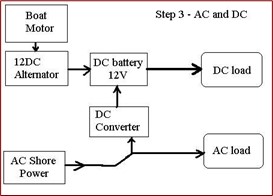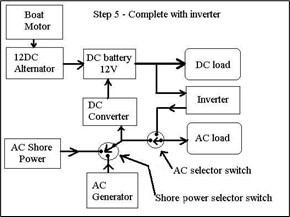The electrical system of a boat is the glue that holds the boat together. Nearly every other system on the boat depends on the vessels electrical system to operate.
What is the Electrical System?
Your boat is designed to run on direct current (DC). Most operate on 12 Volts direct current, abbreviated 12VDC. However, some boats, particularly of foreign manufacturer, may operate on 32VDC or 24VDC. Make sure your new vessel is designed to operate on 12VDC. I would not recommend the purchase of any vessel with a DC system other than 12VDC for the average boater. Although there are ways to get around the difference in voltage it is not something the average boater can do.

The 12VDC battery shown in Step 1 above delivers 12VDC power to the DC load of the boat. This load includes lights, electronic equipment, pumps, and any other system requiring DC power. To replace the power used from the battery the boat motor has an alternator attached to it that recharges your DC battery (s). This is the basic system found on most small boats. All is well as long as you run the boat motor often enough to keep the battery(s) charged.

Variations of this simple system include one or more batteries selected by a battery switch so that one battery can be used to start and run the boat, called the engine battery. See Step 2 drawing. The second battery is called the "house battery" and is used to provide all the DC requirements when the motor is not on. This could be the anchor light, galley lights, etc., but does not include starting the motor.
To use this system to its advantage, you make maximum use of the battery switch. When the engine is off you turn the battery switch to position 2, house battery, and operate your DC systems from the house battery. When ready to start the engine, you switch to position 1, engine battery, and start the engine. (Keep in mind all other DC instruments on your boat will be operating on the engine battery at this point, so don't put a lot of extra items on until the engine is running – radar, VHF radios, GPS, etc.) Once the engine has warmed up, you can switch the battery switch to "both". This position is not shown in the drawing labeled Step 2, but basically connects both batteries to the alternator at once. Now the engine is charging both batteries as needed. When you have reached your destination, you anchor or tie up and shut the engine down. Then as a final step switch to position 2, house battery, while the engine is off.
With this system, and method of operation, if you fail to pay attention and run the house battery all the way down, no harm is done because you can still use the engine battery to start the engine and recharge both batteries. The fact that you may run the battery very low on many occasions is exactly why the house battery must be the deep cycle variety often referred to as Marine Battery. However, deep cycle batteries do not have the cranking power of regular batteries. Therefore, you will install deep cycle (marine or golf cart batteries) for house use and regular batteries for engine use.
Recharging the batteries becomes a major concern for the cruiser and with the basic DC system above some boaters add wind generators and solar panels. The merits of these systems will be discussed later, but do not provide a lot of assistance for the coastal cruiser. For most boaters, the next step in the evolution of electric on the boat is the addition of a battery charger to recharge the batteries from shore power.
Many modern conveniences are manufactured to operate on alternating current (AC) including TVs, microwaves, computers, battery chargers, washers, etc. In the US we use 60 Hz (cycles per second) 120 Volt single-phase power for most applications. Some power hungry appliances like an electric dryer or stove will operate on 240 Volt two-phase power. Because of this most vessels have the capability to accept 120VAC. Larger vessels with bigger AC appliances also need 240VAC two-phase power.
Be careful, foreign countries use 240VAC 60 Hz and 240VAC 50 Hz single-phase power. Again, if you are purchasing a vessel made in or outfitted for England or some other foreign country, you may find the boat wired for 240VAC single-phase 50Hz and it will not function properly on 240 VAC two-phase 60Hz power found in this country. I would not recommend that you buy a boat wired to other than the US standard, unless you have a lot of electrical training and/or experience. There are ways to get around it, but it can be very costly and does require a lot of knowledge.

Step 3 above shows the basic boat system with the addition of shore power. For simplicity I have dropped back to showing only one battery, while in fact you have seen above that there are almost always two banks, engine and house, and in fact in many cases multiple banks of house batteries. These will be addressed later.
When a boat wired as shown in Step 3 is operated, the DC portion functions much the same as shown and discussed in Step 2. The engine alternator charges the battery and all equipment on the boat operates from the battery. However, when the boat is at a dock with shore power the boat wired as in Step 3 has a big advantage. The AC shore power can be connected to the boat and the DC Converter, also called a Battery Charger, will keep the battery charged while the boat is used. In addition AC is directed to receptacles throughout the boat so that you can plug in your favorite electrical appliance (TV, computer, etc) and operate it on your boat while at dockside. In addition, some AC accessories may be hardwired directly to the AC input line through an AC distribution panel permitting the use of these devices when dockside.

Once people started adding AC equipment to their boats it wasn't long before the AC generator was added to the boat. Step 4 shows the basic wiring diagram of boat equipped with a generator. This generator may operate on gas, diesel or propane depending on the boats setup. With the generator a whole new method of operation opened for boaters. You could leave the dock and cruise down the waterway using any and all equipment on the boat. Run the air conditioner or operate the washer/ dryer. Heck, you could even cook with an electric stove.
The AC generator provides the same voltage requirements that the boat has for shore power. However, when underway you set the shore power selector switch to "generator" and start the generator. You can operate everything AC on the boat that you want, within the limits of the generator. I will address that issue shortly. An added benefit of this approach is that the cruiser can drop his anchor in some quiet secluded spot and still operate everything on his vessel. In addition to running all the AC equipment, the generator powers the DC Converter and keeps the boats batteries charged so that all the DC equipment works as well.
Is this a great life or what? Soon, however, boaters began to realize that running a generator was not free. In fact it can be downright costly. The exact cost will be detailed later, however boaters began to look for alternatives. Along came equipment that operated off DC or AC. TVs are a good example. However, they were more expensive than regular TVs and were not that popular.

Next came the inverter. The inverter is a device that takes 12VDC and converts it to 120VAC single phase at 60Hz so you can operate AC equipment without running a generator or being connected to shore power. Step 5 is a basic wiring diagram on the next page that shows how a boat might be wired to accommodate all the bells and whistles.
The major difference between Step 4 and Step 5 is the addition of the inverter and a switch to accommodate it. Now a boater could leave dockside and anchor out and not run his generator, but still use his computer, regular TV or any of a dozen small appliances. As will be shown later, the use of an inverter to run very large appliances is not practical.
The inverter is connected directly to the house battery and provides AC power within its limitations whenever turned on. By simply moving the AC selector switch to inverter, all of the items normally plugged into AC on the boat now have AC power 120V single phase. The only precaution you must take in this hookup is the fact that the inverter has a practical limit as to how much current it can handle. You literally cannot run all AC appliances on the boat at once or you will overload the inverter and it will shut down. This will be covered in more detail in the section of this book on selecting an inverter. However the basic system works great in that you can now anchor for extended periods and operate pretty much as you normally would and not have to run your AC generator all the time you are at anchor.
As an aside you may notice that the AC out of the inverter is not connected to the input to the DC converter. In other words you can't use the AC output of the inverter to operate the DC converter and recharge the batteries that operate the inverter, etc. This would provide unlimited power free if it could be done. Unfortunately there is a loss of power in the operation of both the inverter and DC converter (battery charger) so that the system would quickly discharge itself if you tried this hookup.











